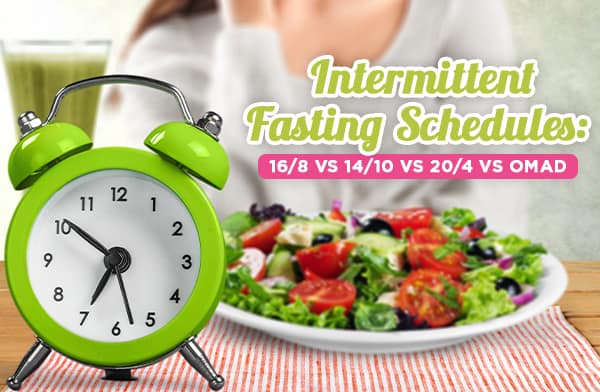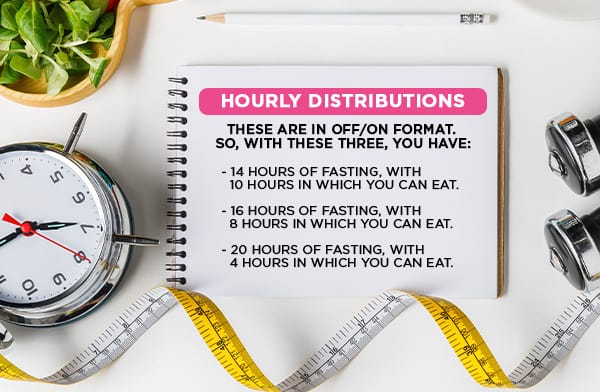Intermittent Fasting Schedules: 16/8 vs 14/10 vs 20/4 vs OMAD

Throughout history, people have tried pretty much anything to lose weight, from starvation to cleanses to fad diets and more. They do this because the best, most permanent way to lose weight is difficult and involves permanent lifestyle changes, and many people don’t want to commit. That said, every single person is different. What works for one person won’t work for another, so finding the right combination of diet and exercise to maximize your own health and comfort is a personal journey.
One of the options many people turn to for weight loss is called Intermittent Fasting, or IM. It’s a fairly self-explanatory concept; intermittently – typically once a day, though not always – you spend time fasting, or not eating anything and drinking only water.
Intermittent Fasting is a powerful technique for weight loss. Many people struggle, not with eating healthy, but with portion control. After all, even a plate full of fruits and veggies can lead to weight gain if you eat 5,000 calories worth of them. It’s often easier to just not eat anything at all than it is to stop eating something tasty.
If you’re interested in intermittent fasting, you’ve probably seen the sets of numbers that come up in discussion. What are 16/8, 14/10, and 20/4? Let’s dig in.
How Intermittent Fasting Works
Intermittent fasting is a diet plan that doesn’t restrict what you eat but rather when you eat. You’re still free to eat whatever delicious foods you want, even if they’re loaded with sugar or otherwise unhealthy ingredients. The trick is, you can only eat within a certain designated stretch of time.
One of the biggest concerns is simply that, during your active hours, you just eat the same amount of food you would if you weren’t performing intermittent fasting. And, sure, you could do that. The thing is, most people don’t.
The biggest issue with the diets of many people is a problem with snacking. Even if your snacks are only 200 calories, eating them constantly all day will result in huge amounts of calories taken in. Unless you’re extremely dedicated to working out, it’s going to be impossible to burn all of those calories.
When you compress the amount of time you’re allowed to eat, you typically eat less. You eat until you’re full, and even if you stuff yourself, you’re probably not going to eat as many calories as you would if you were snacking all day. You could, sure, if you were eating extremely calorically-dense foods and packing them away like a professional eater, but most people won’t.

The other aspect of intermittent fasting that helps with weight loss is the shift from burning calories from food to burning calories from stored fat. Your fasting period means you’re not allowed to eat food to refuel during those specified hours. Your body will digest what you did eat, but once that energy is processed, your body still needs fuel to keep going. There’s only one place to take it, and that’s your stored body fat. As your body burns that fat, you lose weight.
Some of you might be worried about starvation rebounds. One of the biggest issues with extreme caloric restrictions and starvation/crash diets is that they put your body into starvation mode. In starvation mode, you burn stored fat for energy and do whatever you need to survive. However, once you’re done with starvation mode, your body shifts into conservation mode. It knows, genetically, that it’s unpredictable when starvation could happen again. So, it packs the fat back on to insulate against future starvation.
That’s why so many crash diet plans work to lose weight, but then you gain that weight right back.
The power of intermittent fasting is two-fold here. First, since it’s not a full starvation diet, it never pushes your body into full starvation mode, and thus you don’t end up in rebound mode. And second, it’s an ongoing lifestyle change. You don’t practice intermittent fasting for a few months and then stop; you implement it as part of your routine for the indefinite future.
Hourly Distributions
Intermittent fasting is designated by two numbers, which is your off and on. You spend a certain number of hours fasting, and are allowed to eat during a smaller selection of hours. The three most common distributions are the ones I listed in the title; 16/8, 14/10, and 20/4. I’ll get to OMAD in a bit.

These are in off/on format. So, with these three, you have:
- 14 hours of fasting, with 10 hours in which you can eat.
- 16 hours of fasting, with 8 hours in which you can eat.
- 20 hours of fasting, with 4 hours in which you can eat.
To put this into perspective, think of a typical workday. If you work a 9-5 job, that’s eight hours of work. It’s also eight hours in which you can eat. Any time before 9 am or after 5 pm, you’re fasting and cannot eat.
Of course, it doesn’t have to be work hours. You might do something like 11-8, so you start your eating with lunch at 11 am, and eat dinner around 6 pm with the family, with some snacks in between, or a nightcap at 7:30 before you settle in for the evening.
The goal is to be flexible enough to eat when you need to during your active hours but rigid enough to keep those hours. No midnight snacks, no early morning breakfasts, no spreading out your eating throughout the day. Disrupting the schedule will break it.
The 14/10 distribution is a little easier to manage. You have a wider range during which you can eat, which is better for when you have a busy schedule and can’t take the time to eat a full meal during work or active hours. It’s also less restrictive and less likely to make you starvingly hungry during your off-hours.
By contrast, the 20/4 schedule is extremely difficult. Trying to cram all of your day’s nutrition in a 4-hour period is quite difficult. Many people who aren’t used to this will fail to eat enough to keep going and eventually cause themselves issues, or will suffer under such intense hunger pangs or other health issues that they give up.
There are also other schedules out there. I’ve seen people go with 12/12, with 18/6, and pretty much anything else. After all, you’re just subdividing the day.
Some, like 14/10 or 8/16, are extremely easy for most people. After all, if you sleep for eight hours at night, and you don’t eat anything for two hours before bed (as is good practice for proper sleep hygiene), that’s already 10 hours off. Extend it a little more before bed, and take time to do things before eating first thing in the morning, and you’re easily already at a 12/12 schedule.
Another option you might see is something like 10/2 x2, where you do ten hours of fasting, eat during a two-hour window, and repeat twice per day.
OMAD and More
OMAD is intermittent fasting, sort of. It’s similar to 20/4 in that it is very difficult for many people to handle. And, yet, some people take to it naturally.
OMAD stands for One Meal A Day, and it’s just like it sounds. You eat one large meal per day, getting all of the calories and nutrients you need to survive, and that’s it. No snacking. No supplementary nutrition. One meal, once per day, that’s all.
Remember, this includes other sources of nutrition. You’re not drinking juice or soda throughout the day on OMAD, just water and maybe something zero-calorie like tea. You’re also not allowed things like protein powder in a pre-workout.
The meals you eat on OMAD are also quite large since they need to contain all of the calories from all of the food groups you need to survive. For many people, this can be a lot of food to pack down, especially if you’re also focusing on a healthy diet and eating things like veggies and lean meats. Consider what 1,600 calories from a Fast Food Restaurant looks like, and then replace the unhealthy foods with healthier foods.

Since OMAD is more about timing than the food you eat, some people find it doesn’t work because the meals they eat are too large and, themselves, unhealthy. Two Big Macs and a large fry are more than your daily intake, after all.
OMAD isn’t the only extreme fasting option. There are other schedules that, rather than divide the day into hours, divide the week into days. Two of the most prominent are:
- 5:2. This divides the week, allowing you to eat normally five days of the week, and eat extremely little – usually under 600 calories per day – for the remaining two days. Those two days are typically something like Monday and Thursday or Saturday and Wednesday.
- Alternate Days. As you might assume, the alternate days fasting plan is an on-off plan where you eat normally one day and eat little or nothing the next, switching every day.
As you can see, there are a huge variety of different fasting plans. There’s just one question: which one is best?
Which Schedule is Best for You?
Intermittent fasting schedules are extremely varied, specifically because people are extremely varied. What works for one person might not work for another. You want a fasting schedule that challenges you, but not one that is impossible to maintain.
I don’t usually recommend intermittent fasting in the first place. My diet plan is more focused on what you eat rather than when you eat. However, if you were going to do intermittent fasting, I would recommend starting with something like a 16/8 schedule. It’s challenging, but not impossible, and it can give you an idea of how your body reacts to not having food on hand.

I strongly urge you to make sure you don’t have any health issues before you do this. In particular, diabetes can be extremely challenging to manage with intermittent fasting. That’s because diabetes is a problem with your body’s ability to regulate blood sugar. Sugar crashes can be extremely dangerous and cause cognitive problems, and your blood sugar is likely to tank by the end of your fasting period.
Additionally, no matter what fasting schedule you choose, you need to make sure you’re getting proper nutrition. If you restrict yourself to just two meals per day in a narrow window, it’s easy to forget to eat a particular food group or end up not getting certain vitamins or minerals you need. Many intermittent fasting proponents also recommend multivitamins for this reason.

So, what should you choose? Generally, you have a few options.
- Start with 16/8. This is the “easiest” plan that is still challenging and restrictive. Many of the plans that offer more flexibility don’t actually challenge you and thus won’t actually result in weight loss.
- Try OMAD or 5/2. Restricting yourself to one meal a day or to two days off per week can have a larger impact while being a different kind of challenge.
- Try 10/2 x2. For many people, the problem they have with sticking to a diet is snacking. A plan that lets you eat meals, but enforces a no-snacking rule, can help.
- Do something completely different. If you find that restricting the time you can eat doesn’t actually help you, you can try out the Smoothie Diet.
The Smoothie Diet is a diet plan that replaces your breakfast and lunch with low-calorie, healthy smoothies, while helping you shift the rest of your diet towards more healthy alternatives to whatever you’re eating now. If you stick with it, it works as a calorie-cutting diet as well as a shift to healthier foods without the stress and hunger of intermittent fasting.
The truth is, there’s no one right option for everyone, because everyone operates differently. Experiment with different diets and find the one that clicks with you.
Do you have any questions or concerns regarding any of the intermittent fasting options, the Smoothie Diet, or anything similar? If so, please feel free to reach out and contact me at any time! I’d be more than happy to assist you with your weight-loss journey however I possibly can!






